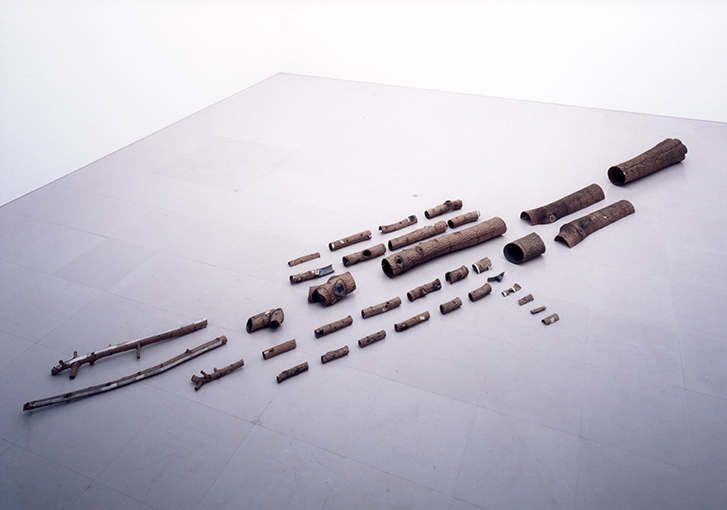
[Audio Guide]
A large tree has been cut down and arranged in several sections. On approaching, one sees that the interior of each piece of wood is hollowed out, structured in some way, and painted entirely blue. Closer inspection reveals that most of the trunk and branch segments have been split vertically in half and then reassembled. While the tree maintains its natural form after being transformed into an artwork, devoid of external decorative elements, the construction is highly meticulous and labor-intensive. When one thinks of the time needed to complete this work, one also recognizes the time encapsulated within the tree, which likely required decades to grow to its current size. While carving the trunk’s interior, the artist must have perceived the depth of time conveyed by the tree rings. As a tree grows and accumulates rings, it expands and occupies more of the surrounding space. In his work as a sculptor, Wakabayashi was evidently keenly aware of temporal aspects in his observations of space.

[Audio Guide]
A large number of pieces of paper, bound together and hardened into blocks, are connected to a pillar with copper wire. One may be reminded of dogs on a leash, but this does not seem to be a clue that brings us closer to the work. The fact that the lower halves of the paper strips are dyed blue has only a faint association with the Submergence of the title. The artist, Wakabayashi Isamu, once wrote a short essay about rivers’ water levels rising due to heavy rain. The artist also likened the way the opposite bank advances and recedes, as the water level rises and falls, to a change in distance from the subject, and used the rise and fall of the river water as a key to capturing space, in the same manner as a sculptor. In this light, it seems the mass of paper strips can be seen as something that can be lengthened by adding more paper, or conversely, can be shortened by tearing it off. Wakabayashi evidently endeavored to capture space with a scale resembling an expanding and contracting spring.
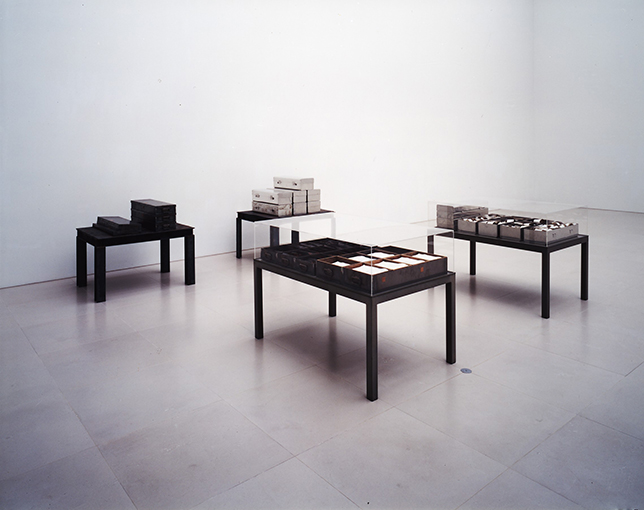
[Audio Guide]
Iron and aluminum boxes are placed on tables, some with their lids removed to expose their contents. Inside the boxes are walnut leaves, copper plates cut into leaf shapes, and pieces of paper with rubbings of leaves, sorted into categories. The title and the years of creation indicate that the work incorporates three years’ worth of walnut leaves. The careful and patient effort required to make rubbings from a multitude of leaves and cut shapes out of copper plates is extraordinary. Wakabayashi once stated, “In an environment full of plants, the zone of the atmosphere from the ground up to my own height is a tactile one. Everything above this is in the visual realm, while the underground belongs to the imagination.” Plants evidently played a crucial role for Wakabayashi as a sculptor who sought to grasp atmospheres or spaces. This work, the result of three years spent collecting walnut leaves, not only reflects the depth of the space that nature occupies, but also conveys the accumulation and density of time.

[Audio Guide]
Each of these four works has its own distinctive atmosphere, although all are swathed in shades of grayish green and blue. The prints all feature arc-like shapes or several lines resembling trenches, along with a multitude of fine lines of varying lengths and patterns of numerous circles. Some evoke landscapes, while others present a more abstract appearance. The title Several Stratums perhaps reflects the artist’s focus. The overlapping arcs and lines may represent geological strata, and the profusion of lines vegetation covering the earth’s surface. Meanwhile, the parallel areas of color and the circles superimposed on them suggest a schematic depiction of geological layers and vegetation. As a sculptor, Wakabayashi produced works grounded in contemplation of the subjects and surfaces he observed, as well as the spaces between himself and these subjects. He interpreted surfaces as having depth and occupying space. Judging by these works, it seems he also perceived the thickness of the earth’s surface in terms of strata.
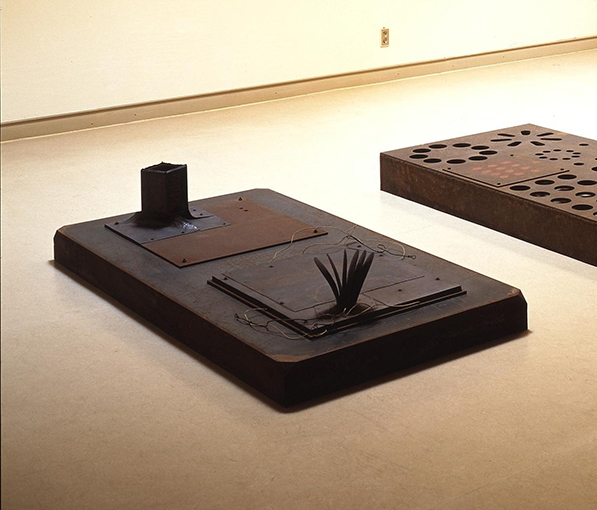
[Audio Guide]
Composed of flat, box-like iron plates, with holes drilled into the top surfaces and protrusions attached, the work at first has an inorganic appearance. However, one’s impression changes upon learning that Wakabayashi placed the first pieces he created, numbered II and III, outdoors and observed plants growing through the holes in them. Also, work V was sometimes exhibited filled with soil and had grass planted in it. In the 1980s, Wakabayashi engaged in wide-ranging contemplation of spaces between himself and the objects on which his gaze fell. As a sculptor attempting to perceive these spaces, he found essential clues in plants. If one interprets the “Possession” in the title as perception and the “Atmosphere” as space, these works can be seen as implements or measuring devices Wakabayashi used to comprehend space. Using plants as a means of capturing “Oscillation,” these instruments can facilitate apprehension of the space they occupy.
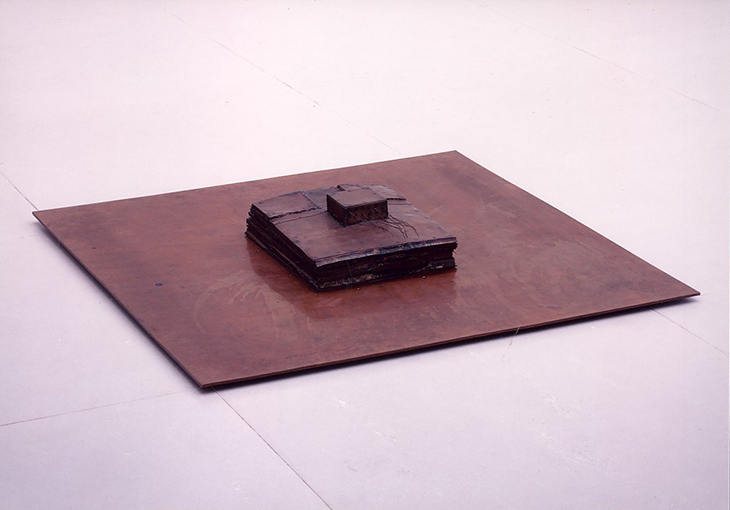
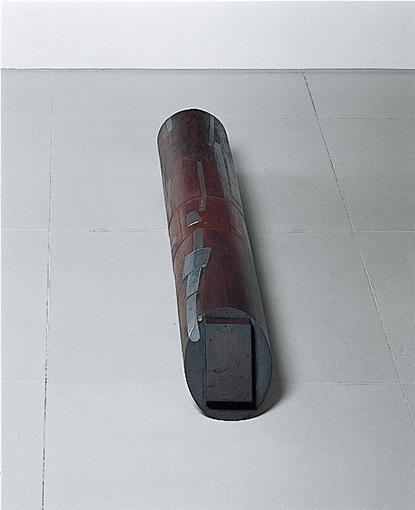
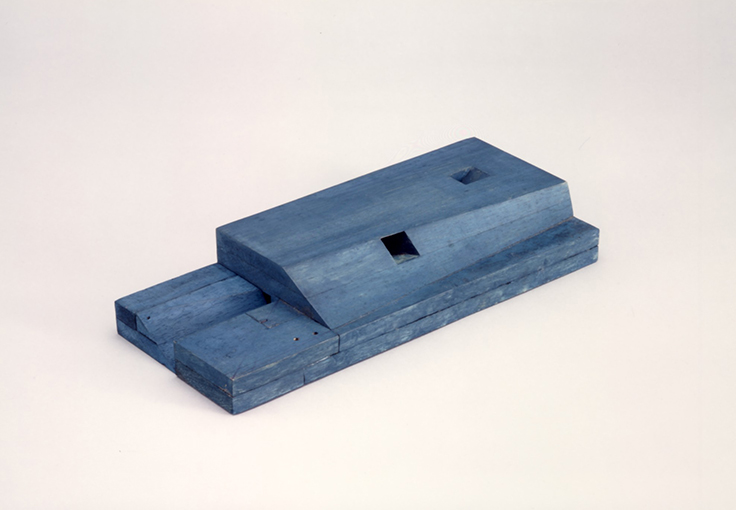
[Audio Guide]
Various wooden parts of diverse shapes and sizes have been assembled to create an array of three-dimensional works. Some resemble scale models of some kind of large structure, another is an elongated rod, there are table-like forms with protrusions and inclines, and some pieces incorporate elements resembling airplane parts or bird feathers. On closer inspection, each surface has been manually modified, and there are dents, bulges, drilled holes, and numerous blade marks. This group of works is from a period when Wakabayashi was deepening his exploration of the relationship between sculptures and the spaces around them, with surfaces as boundaries between the two. As the title implies, it has the quality of a notebook, compiled in order to organize and clarify the artist’s thoughts. This is also reflected in the numerous inscriptions on the surfaces. The juxtaposition of associated and incongruous words in the “gas, solid, liquid, present” of the title seems to point to a process of trial and error as the artist worked out his ideas.

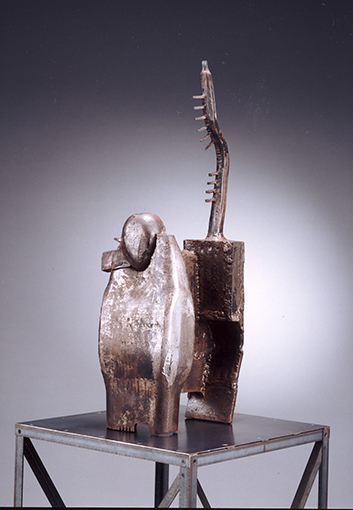
[Audio Guide]
The front part of this sculpture resembles a human being, while the back looks like an animal with a tail. One wonders what the artist was trying to express, but it might be better to move away from thinking that he sought to express something with a tangible form. A closer look reveals that this sculpture is the result of an enormous amount of labor. We can envision the artist wrestling with the steel, heating the material and hammering it into shape while it remains soft for a few dozen seconds, shaving and polishing the hard surface with a grinder, and welding together various parts of assorted sizes. However, it was only the artist who saw the iron in its heated state, glowing red, and its shimmering white-gold tones immediately after polishing. More than creating a specific form, Wakabayashi seems to have been examining the properties of iron and exploring its potential as a material.
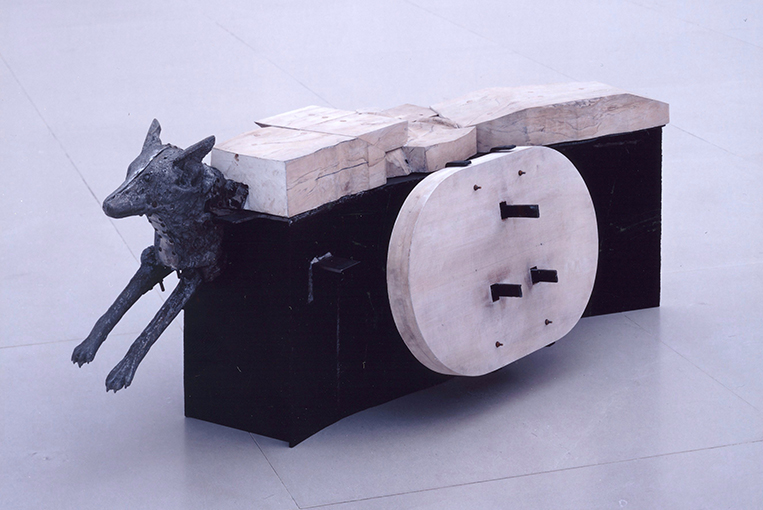
[Audio Guide]
The head and forelegs of a dog have been fashioned out of an iron framework like you might find on a construction site. Lumps of wood that also look like building materials line the section corresponding to the dog’s back. Looking closer, one end tapers to a point as if it were the dog’s tail. If we get even closer and look from directly above, the center of the elongated wood configuration is curved, and it has a silhouette that resembles the main island of the Japanese archipelago. If we view the work with this in mind, the gentle, cone-shaped protrusion can be seen as a symbol for the Japanese landscape. This interpretation fits with the “Grand Landscape” mentioned in the title. As a sculptor, Wakabayashi has an intense interest in the surface of his works. If we broaden our gaze, the surfaces of the things around us come to form the topography of the landscape, even the topography of the Earth’s surface. Through creating a sculpture, Wakabayashi has the sensation of viewing the Japanese archipelago from the sky.